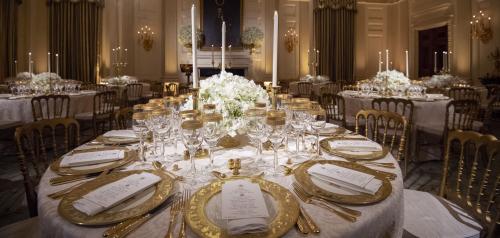Now all the ceremony and pomp of the state dinner for the President of France "is one with Nineveh and Tyre," and Etiquetteer applauds First Lady Melania Trump for orchestrating the entire thing with her staff and without a professional event planner. No less an authority than Emily Post Herself declared hostesses need to know. "It is almost safe to make the statement that no dinner is ever really well done unless the hostess herself knows every smallest detail thoroughly."*
It's been a long time since a traditional U- or E-shaped table has been used at the White House for a state dinner. J.B. West, whose indispensable memoir Upstairs at the White House provides so much detail about mid-century official entertaining, recalled that no more than 104 diners could be seated at the U-shaped table the Trumans used. Jacqueline Kennedy introduced round tables to accommodate more people in the State Dining Room; subsequent administrations introduced tents to seat even more people.
Frankly and candldly, Etiquetteer likes this return to the smaller (read: less than 200) state dinner (though Etiquetteer would have done so without eliminating an entire political party from the guest list). But those tables looked crowded, place settlings jostling each other for elbow room. The etiquette experts of yore used to insist on 18 inches between place settings, but for a 60" or 72" round table you might only fit four people using that rule. Still, the tables looked uncomfortably squeezed.
Previous administrations have obscured what is unique about the White House with special effects, often colored and/or patterned lights, perspex chairs, or rented equipment such as china. As Etiquetteer has said so often before, the White House only needs to look like itself - not, say, a casino or a cruise ship - because there's nothing else like it. While the pinspotting of the table centerpieces and the uplighting around the walls of the State Dining Room might be considered theatrical, those all-white lights enhanced rather than obscured the room. The one light missing was one on the Healy portrait of President Lincoln over the mantel. (That said, Etiquetteer longs for the return of pink silk candleshades - so flattering to complexions.)
All that white light (and the beautiful all-white floral arrangements) emphasized the heavy gold bands of the Clinton china and the glasses with heavy gold borders. All that gold is very on-brand for the Trumps, but what Etiquetteer noticed more was the absence of red and blue. The United States and France share national colors, but in France it's worth noting that white was the color chosen by the royalists. At some point early in the French Revolution, the royalists would declare themselves by fixing their tricolor cockades so only the white would show. Symbolism matters.
A well-run dinner of ceremony can only reflect credit on its host nation, and its hostess. Etiquetteer will be eager to see how the First Lady succeeds with the next state dinner of the administration.
*Emily Post, Etiquette, 1922, page 184. Quoted without permission.

